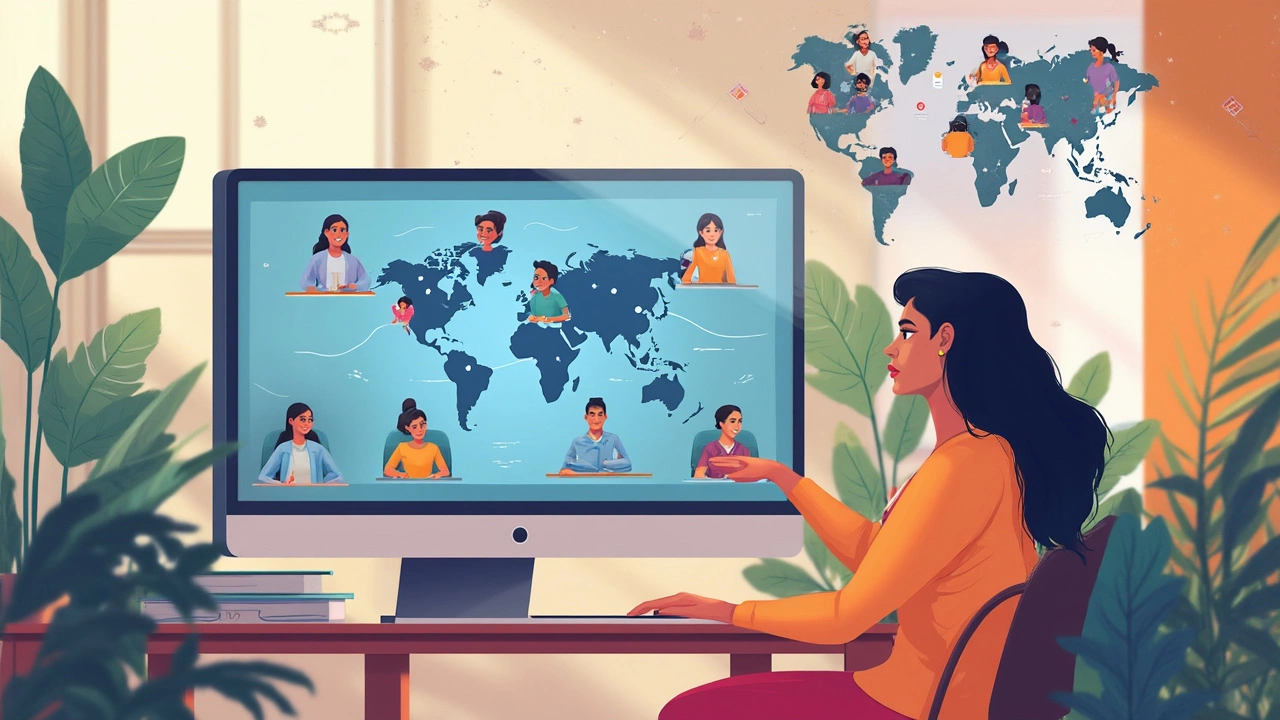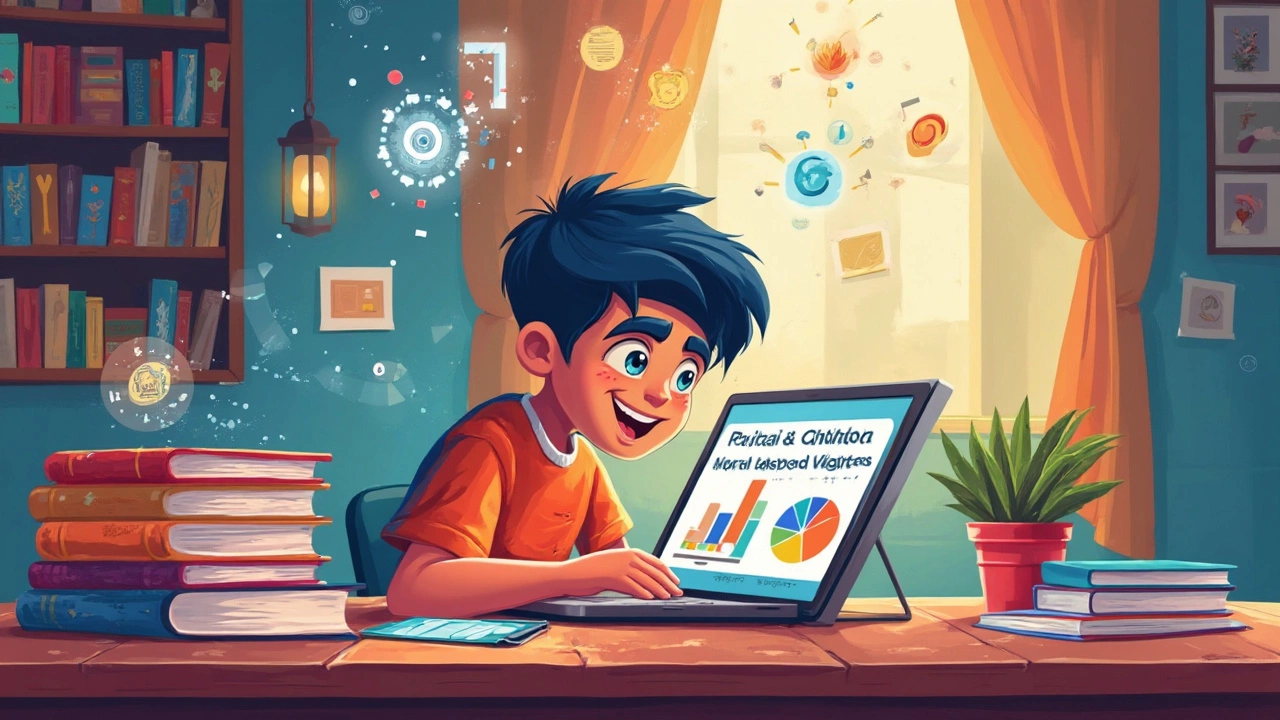You might think eLearning and online learning are interchangeable, but they actually serve different educational purposes. eLearning is all about courses and structured learning, kind of like being in a digital classroom. Here, everything's planned out, like your own self-paced school syllabus. You usually find eLearning in corporate training or schools using specific eLearning platforms.
On the flip side, online learning is the wild child of the two. It covers anything you learn online, whether it's a detailed Harvard course or a quick YouTube tutorial. It's less about structure, more about variety, letting you jump from topic to topic as you wish. Think of it as the open world of education.
- Defining eLearning and Online Learning
- The Advantages of Each Method
- Common Misconceptions
- Choosing the Right Method for You
Defining eLearning and Online Learning
When it comes to digital education, people often mix up eLearning and online learning. While they might seem like twin concepts at first glance, they have their own unique qualities. Understanding these can help match your learning style with the right method.
eLearning: The Structured Path
Imagine having a virtual classroom where you follow a set curriculum. That's your typical eLearning scenario. This method is particularly popular in corporate environments or educational institutions. It usually involves courses that are interactive and consistent, often through eLearning platforms like Moodle or Blackboard.
eLearning comes with structured content which includes quizzes, interactive modules, and sometimes live discussions. So, it's like being in school but in the comfort of your home, and pacing yourself as per your schedule.
Online Learning: The Wild West of Education
In comparison, online learning embraces a more freeform style. It's the umbrella term for any learning process that uses the internet. Whether it's a quick video tutorial on gardening or an advanced coding course, if it's online, it fits here.
Online learning shines through its diversity. It covers a range of resources and teaching styles—from formal certifications to casual learning experiences. Unlike eLearning, there is no set path or centralized platform guiding you through the content.
What Sets Them Apart?
- Structure: eLearning is structured with specific learning goals, while online learning offers a more flexible and varied path.
- Purpose: eLearning is curriculum-based often used for formal education, whereas online learning can be for personal growth or skill enhancement.
- Platforms: eLearning happens on dedicated platforms, while online learning can be on any website or application.
Defining these terms is just the beginning. Choosing between them depends on your personal learning goals, whether you want the rigour of a structured program or the freedom to explore various topics.
The Advantages of Each Method
When it comes to education, no one-size-fits-all approach exists. eLearning and online learning each come with their own unique advantages that appeal to different types of learners and scenarios. Understanding these can help you make an informed decision.
Structured and Tailored: The eLearning Edge
eLearning platforms shine in scenarios where structured learning paths are critical. Whether it's a corporate training program or an academic course, eLearning delivers consistency. According to corporate trainer Jenna Matthews, "eLearning ensures every employee or student receives the same high-quality training experience regardless of their location."
Moreover, eLearning often includes assessments and feedback mechanisms that ensure learning objectives are met. These platforms frequently provide interactive elements like quizzes, video demonstrations, and simulation exercises to keep learners engaged. This structured format is perfect for goal-oriented learning where you want to track your progress step by step.
Flexible and Diverse: The Online Learning Advantage
If you crave flexibility and a wide range of topics, online learning is your playground. From ancient history to cutting-edge tech, the diversity of resources out there is endless. Online learning doesn't tie you down to a set curriculum, so you get to choose your path.
Fancy taking a course from a professor at MIT without leaving your couch? Platforms like Coursera and edX offer these opportunities, bringing the classroom to your living room. Also, online learning allows crazy levels of customization in terms of time and even methods of learning – ideal for night owls, multitaskers, and lifelong learners alike. Let's not forget the informal learning community you find on the internet, with forums, community groups, and social media all playing a role in fostering vibrant learning discussions.
"Learning is not attained by chance, it must be sought for with ardor and attended to with diligence." – Abigail Adams
This balance of structured guidance and free exploration can create a rich learning environment. Both methods have their places depending on what you need out of your educational experiences.

Common Misconceptions
When it comes to distinguishing between eLearning and online learning, there's a lot of mix-up. Let's set the record straight.
Misconception 1: They're the Same Thing
A lot of people think eLearning and online learning are just two ways of saying the same thing. They’re not! As mentioned before, eLearning is all about structured courses with a clear syllabus. It's like having a classroom online where you often follow a set schedule. On the other hand, online learning is broader – it's any learning you do on the internet, structured or not.
Misconception 2: One is Better Than the Other
Some folks believe eLearning is superior because it's more formal or that online learning is better due to its flexibility. Neither is universally better; it depends on what you need. If you prefer a clear path and syllabus, go with eLearning. If you like jumping from one topic to another, online learning might be your jam.
Misconception 3: Online Learning is Always Informal
It's easy to think online learning means unorganized or casual study. While it often offers that freedom, it can also involve complete courses from universities or platforms that rival traditional classroom learning in depth and rigor.
Misconception 4: You Need High Tech Gadgets for Both
Not true! While having fancy tech might enhance the experience, both eLearning and online learning can be accessed with basic devices. A computer with internet access is usually enough to get you rolling.
Get these misconceptions cleared up, and you’ll be in a much better position to choose the right learning method. Whether it’s a formal eLearning program or a more casual online learning journey, you’ll know what’s right for you, without any mix-ups!
Choosing the Right Method for You
Picking between eLearning and online learning is like deciding between a buffet and a set menu. Each has its perks depending on what you’re hungry for. Here’s how to decide which fits you best.
Consider Your Learning Style
If you're someone who thrives on structure and likes a clear path from start to finish, eLearning might be your jam. It offers a planned and consistent rhythm, similar to traditional classroom settings but in a digital way. You're likely to find progress tests, assignments, and deadlines to keep you on track.
On the other hand, if you prefer exploring at your own pace and diving into various topics, online learning lets you cherry-pick what interests you. It's like a treasure chest of knowledge, letting you pivot and explore different subjects whenever curiosity strikes.
Time Commitment
Do you have a set amount of time to dedicate to learning, or does your schedule change from week to week? eLearning often requires consistent dedication and routine, which is great if you can schedule regular study time. In contrast, online learning offers flexibility and can adapt to your busy lifestyle, allowing more sporadic or binge-style learning sessions.
Goals and Outcomes
Your educational goals also play a big role here. If you need a certification or structured skillset, then eLearning could align with your objectives since it often ends with formal recognition. In fields like IT or project management, recognized courses may even be a job requirement.
However, if you're just keen on expanding your horizons or picking up a hobby, online learning is perfect, offering endless resources from expert lectures to community-sourced content.
Cost
Finally, let’s talk about cost. Generally, eLearning can be more expensive since it involves curated content and may even provide official certifications. Online learning often ranges from free to less costly programs, making it accessible for simply gaining knowledge without going broke.
Our daily digital interactions increasingly blend work and play, knowledge and entertainment. Balancing what you aim to achieve with how you learn best is the real key to unlocking your full potential.
